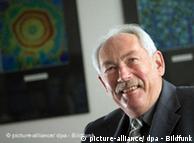他們是因為巨磁電阻材料方面的發現而獲獎的。
他們分別是69歲的法國科學家阿爾貝﹒費爾和68歲的德國科學家彼得﹒格林貝格。
他們的發明讓人們可以從電腦硬盤上讀取數據。
這種技術也讓硬盤可以變得越來越小。
兩位科學家發明的技術也稱為GMR,廣泛用於電腦開發方面。
這種技術用於發展敏銳的工具,可以讀取電腦硬盤上的數據,包括手提電腦,以至個人小型音樂播放器,以及錄像播放裝置等。
皇家瑞典科學院在宣佈兩人獲獎的讚詞中說,這種技術的使用讓讀取硬盤上的資料的程序改觀。
讚詞同時說,兩人的發現也可以被認為是真正使用納米技術方面的其中一項創先河做法。
兩人將分享150萬美元的獎金。
Today's highlight on DW-WORLD:
German and French Science Duo Share Nobel Physics Prize
Peter Grünberg of Germany and Albert Fert of France have been awarded the Nobel Physics Prize Tuesday for their work which led to the miniaturized hard disk, one of the breakthroughs of modern information technology.
To read this article on the DW-WORLD website, just click on the
internet address below:
http://newsletter.dw-world.de
Grünberg of Germany shares Nobel Physics Prize
Peter Grünberg of Germany and France's Albert Fert have won the Nobel Prize for physics. The two won the award for their discovery of "giant magnetoresistance" or GMR in 1988. This technology paved the way for radically increased computer storage capacity. The Royal
Science | 09.10.2007
German and French Science Duo Share Nobel Physics Prize
Peter Grünberg of Germany and Albert Fert of France have been awarded the Nobel Physics Prize Tuesday for their work which led to the miniaturized hard disk, one of the breakthroughs of modern information technology.
The two scientists, who worked independently, were lauded for discovering a principle called giant magnetoresistance, or GMR, which the Royal Swedish Academy of Sciences called in its citation, "one of the first real applications of the promising field of nanotechnology."
Grünberg and Fert discovered in 1988 that minute magnetic changes in a GMR system lead to huge differences in electrical resistance. These differences in turn cause changes in the current in the readout head, which scans a hard disk to spot the ones and zeroes in which the data is stored.
As a result, the readout head is able to read smaller and weaker magnetic areas -- and this sensitivity means information can be packed more densely on the hard disk.
Prize for practical application of nanotechnology
 Bildunterschrift: Großansicht des Bildes mit der Bildunterschrift: Albert Fert is honored for his work on the miniature hard drive
Bildunterschrift: Großansicht des Bildes mit der Bildunterschrift: Albert Fert is honored for his work on the miniature hard drive
Martin Durrani, editor of Physics World, a journal published by Britain's Institute of Physics, said the award was fitting.
"I am really pleased that it has gone for something very practically based and rooted in research relevant to industry," he said. "It shows that physics has a real relevance not just to understanding natural phenomena but to real products in everyday life."
Last year, the Physics Prize went to US space scientists John Mather and George Smoot for a pioneering space mission which supports the "Big Bang" theory about the origins of the Universe.
Grünberg and Fert will be honored at a formal prize ceremony held as tradition dictates on Dec. 10, the anniversary of the death in 1896 of the prize's creator, Swedish industrialist and inventor of dynamite Alfred Nobel.
The 2007 laureates will receive a gold medal, a diploma and 10 million Swedish kronor ($1.53 million, 1.08 million euros) to be split between them.
Grünberg and Fert discovered in 1988 that minute magnetic changes in a GMR system lead to huge differences in electrical resistance. These differences in turn cause changes in the current in the readout head, which scans a hard disk to spot the ones and zeroes in which the data is stored.
As a result, the readout head is able to read smaller and weaker magnetic areas -- and this sensitivity means information can be packed more densely on the hard disk.
Prize for practical application of nanotechnology
 Bildunterschrift: Großansicht des Bildes mit der Bildunterschrift: Albert Fert is honored for his work on the miniature hard drive
Bildunterschrift: Großansicht des Bildes mit der Bildunterschrift: Albert Fert is honored for his work on the miniature hard driveMartin Durrani, editor of Physics World, a journal published by Britain's Institute of Physics, said the award was fitting.
"I am really pleased that it has gone for something very practically based and rooted in research relevant to industry," he said. "It shows that physics has a real relevance not just to understanding natural phenomena but to real products in everyday life."
Last year, the Physics Prize went to US space scientists John Mather and George Smoot for a pioneering space mission which supports the "Big Bang" theory about the origins of the Universe.
Grünberg and Fert will be honored at a formal prize ceremony held as tradition dictates on Dec. 10, the anniversary of the death in 1896 of the prize's creator, Swedish industrialist and inventor of dynamite Alfred Nobel.
The 2007 laureates will receive a gold medal, a diploma and 10 million Swedish kronor ($1.53 million, 1.08 million euros) to be split between them.

1 則留言:
德国人将诺贝尔物理奖揽入怀中
今年的诺贝尔物理奖被德国人获得。诺贝尔委员会今天在斯德哥尔摩宣布,将今年的诺贝尔物理奖授予德国人彼得.格林贝格和法国人阿尔贝特.费尔特。
授予诺贝尔奖是为了表彰两人发现巨型磁阻效应(GMR,gigant magnetoresistive effect)。上个世纪80年代晚期,他们通过实验了解到,由很细的、各种金属和非金属物质交替层组成的材料在相同的磁场变化下能引起更大的电阻值变化。
他们的发现如今被应用在磁盘驱动器上。与其配套的是最新一代硬磁盘存储器,它所提供的数据密度几乎是其前一代磁阻磁头技术提供的三倍。利用MR(磁阻)技术,每平方英寸至多能够存储3.3 GB,而使用GMR技术能够每平方英寸能够存储进10 GB。随着数据存储密度的增大,精确读数据的设备也需要与数据存储密度保持一致。GMR的设计目的就是使尽可能多的可以精确得到的数据存储到磁盘上,使运动机件尽量的少。基于GMR技术的磁盘驱动器利用了上述特性,有助于控制对磁盘非常小的旋转动作作出反应的传感器。
德国人彼得.格林贝格1939年5月18日出生于比尔森(今捷克境内)。他研究的重点是固体物理学。他曾在法兰克福和达姆施塔特上大学,1969年获得博士学位。1972年,他开始了在德国尤利希研究中心的工作。在此期间,他也曾做过客座教授在科隆大学讲学。2004年退休后,格林贝格继续在尤利希研究中心固体研究所(IFF)电子性能所(IEE)担任客席工作。
格林贝格是最早研究电磁“薄层”的科学家之一。这个被称作“自旋电子学”的研究领域是电子自旋的特性。1998年格林贝格因为他发现GMR效应的论文被授予联邦总统奖。2006年欧盟委员会和欧盟专利局的《大学和科研机构目录》中他获得“年度欧洲发明家”的称号。2007年他还获得了德国物理协会(DPG)的奖章,以色列议会授予他沃尔夫物理奖。
2007年4月格林贝格和他的同伴,法国巴黎大学的阿尔贝特.费尔特,在日本东京接受了日本天皇授予的“日本奖”,表彰他们在基础研究领域的创新。现在,诺贝尔物理奖无疑是对两人杰出成就的再一次肯定。德国人上次获得该诺贝尔物理奖是2005年,慕尼黑大学物理教授特奥多尔?亨施和其他两名美国学者分享了这一奖项。
張貼留言